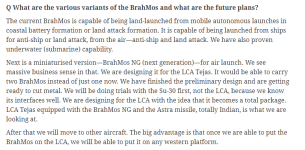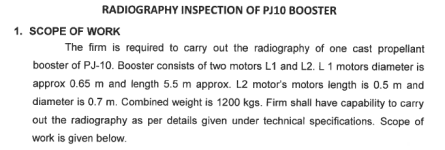Brahmos Supersonic Cruise Missile : News, Updates and Discussions
- Thread starter Manmohan_MMY
- Start date
Look in that interview 2 months ago DR Rane specifically mentioned Brahmos was never meant for nuke use. It is a conventional warfighting weapon & will remain so. As Dr Kalam famously said re warheads, you can put flowers in it if you want to. So this is a question for the policymakers . But as a weapon for export, Brahmos was & will always be a conventional missile.
Top Argie officials visiting Brumos today, compared to tejas related visits previously, this is an actual high level delegation that may be a serious party.
In other news, though its from the print.
In other news, though its from the print.
One more decent article on Brahmos
 www.iadb.in
www.iadb.in
BrahMos Supersonic Cruise Missile-Superlative Weapon For ‘Cruise Missile Triad’ - Indian Aerospace and Defence Bulletin - News for aerospace and defence in India
Made in India BrahMos supersonic cruise missile is a game changer today because of its audacious capability to execute extremely precise attacks against targets defended by most complex and lethal AD systems both at sea and on land.
Future is subsonic LO Cruise Missiles......Brahmos is a over expensive over Hyped Missile.
Nirbhay failure like most of DODO failure has been a real disaster. Thy can't complete one Project & immediately start running towards other resulting in more & more failure , no accountability nothing.
Nirbhay failure like most of DODO failure has been a real disaster. Thy can't complete one Project & immediately start running towards other resulting in more & more failure , no accountability nothing.
Not sure why would they want 3 versions assuming land, ship and air launched. They are landlocked country.
Yes, surprising as they don't even have a navy. Air Launched BrahMos for their fleet of Su-30SM and land launched versions are perfect for them as per common discretion.Not sure why would they want 3 versions assuming land, ship and air launched. They are landlocked country.
Armenia has really turned towards India after Russia double-crossed them by vetoing their use of Su-30SMs against Azerbaijan. Good for us though

(theigmp, aug.22)
Brazil Explores BrahMos-NG SLCM for its Nuclear Submarines
Brazil, renowned for its strategic maritime location, has demonstrated a keen interest in fortifying its naval prowess by integrating advanced technologies into its naval fleet. Recognizing the significance of possessing an indigenous submarine-launched missile system, Brazil’s defense establishment is actively considering the prospect of acquiring BrahMos-NG SLCM under development by India.
The Brazilian Navy is very much eager to integrate India’s 290 kilometers range Mach 3.5 capable BrahMos-NG cruise missile on its first nuclear-powered attack submarine Alvaro Alberto which is based on the French Scorpene class and this development comes at a time when BrahMos Aerospace has already started developing torpedo tube-launched version of BrahMos-NG for the six Kalvari class (Scorpene) submarines in service of the Indian Navy.
The deliberations surrounding the potential collaboration between Brazil and India in the domain of submarine-launched missile technology underscore the significance of diplomatic engagements aimed at fostering technological partnerships. Bilateral discussions in this realm reflect the shared commitment of both nations to strengthen their maritime security preparedness through cooperative endeavors.
The potential supply of Indian-manufactured BrahMos-NG SLCMs to Brazil’s nuclear-powered submarine fleet has the potential to reshape the dynamics of maritime defense strategies across the globe. This envisaged partnership could serve as a testament to the willingness of nations to transcend geopolitical boundaries and cooperate on crucial defense technologies.
The intent of Brazil to explore Submarine-Launched Cruise Missile technology marks a pivotal juncture in the international defense landscape. As both nations contemplate a partnership that could foster technological exchange and enhance maritime defense capabilities, the outcome of this potential collaboration could reverberate beyond bilateral interests, influencing the broader dynamics of maritime security. This pursuit serves as a reminder that the evolution of defense technologies is increasingly reliant on cooperative ventures, transcending geographical confines for the collective goal of ensuring global maritime stability. /end
This is probably too stretched, noticed that a seminar paper from June included Brahmos deputy GM as one of the researcher/co author.
Like the HSTDV related paper, it mentions of specific condition, varying flow at M 4-7 in a 20-25km altitude. I wonder if that is going to be boundary envelope for brumos 2 or not. HSTDV was 6.5M at 32km altitude both in papers and the test, followed precisely for scramjet op. In theory I would have thought it would be like R2, post release pulls up to a 40km apogee flight altitude & quasi ballistic trajectory to evade AD.

Like the HSTDV related paper, it mentions of specific condition, varying flow at M 4-7 in a 20-25km altitude. I wonder if that is going to be boundary envelope for brumos 2 or not. HSTDV was 6.5M at 32km altitude both in papers and the test, followed precisely for scramjet op. In theory I would have thought it would be like R2, post release pulls up to a 40km apogee flight altitude & quasi ballistic trajectory to evade AD.

Just imagine Tu-160M2 or B-1B Lancer carrying dozens of this missile and then the enemy will most definitely be grossly effed. Till then MKI+ BrahMos-A remains our best option to dish out pain to our duo hostile neighbours and then some

Fact remains that the phat missile is too heavy to be carried by even the biggest IAF jet the MKI.Just imagine Tu-160M2 or B-1B Lancer carrying dozens of this missile and then the enemy will most definitely be grossly effed. Till then MKI+ BrahMos-A remains our best option to dish out pain to our duo hostile neighbours and then some
27 MKI were to be specially strengthened to carry Brahmos. But so far only 3 have been completed with additional girders , so that it can carry the 2.5 tonner, underslung.
Sad state of preparedness and Indian businessmen milking the project.
Fact remains that the phat missile is too heavy to be carried by even the biggest IAF jet the MKI.
27 MKI were to be specially strengthened to carry Brahmos. But so far only 3 have been completed with additional girders , so that it can carry the 2.5 tonner, underslung.
Sad state of preparedness and Indian businessmen milking the project.
Around 80 MKIs have been upgraded so far to carry Brahmos missiles. All of them the remaining will be upgraded eventually. The business profiting from this is a PSU (joint venture between us and the Russians). Therefore, there is no such businessman.
We have BrahMos modified aircraft in almost all squadrons of the IAF: Air Chief Marshal
The combination of BrahMos on the Sukhoi Su-30 has really given us tremendous capability that has enhanced our firepower, Indian Air Force (IAF) Air Chief Marshal (ACM) V. R. Chaudhari said








